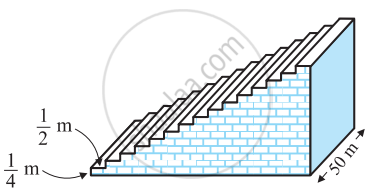Advertisements
Advertisements
प्रश्न
A small terrace at a football field comprises 15 steps, each of which is 50 m long and built of solid concrete. Each step has a rise of `1/4` m and a tread of `1/2` m (See figure). Calculate the total volume of concrete required to build the terrace.
[Hint: Volume of concrete required to build the first step = `1/4 xx 1/2 xx 50 m^3`]

उत्तर
From the figure, it can be observed that
1st step is `1/2` m wide,
2nd step is 1 m wide,
3rd step is `3/2` m wide.
Therefore, the width of each step is increasing by `1/2` m each time whereas their height `1/4` m and length
50 m remains the same.
Therefore, the widths of these steps are
`1/2,1, 3/2, 2`,...
Volume of concrete in 1st step = `1/4 xx1/4 xx50 = 25/4`
Volume of concrete in 2nd step = `1/4 xx 1xx 50 = 50/4`
Volume of concrete in 3rd step = `1/4 xx 3/2 xx 50 = 75/4`
It can be observed that the volumes of concrete in these steps are in an A.P.
`25/4,50/4, 75/4,...`
a = `25/4`
n = 15
and d = `(50/4 - 25/4)`
d = `25/4`
∵ `S_n = n/2[2a + (n - 1)d]`
`S_15 = 15/2[2(25/4)+(15-1)25/4]`
`=15/2[25/2+((14)25)/4]`
`= 15/2[25/2 + 175/2]`
=`15/2(100)`
= 750
Volume of concrete required to build the terrace is 750 m3.
APPEARS IN
संबंधित प्रश्न
Ramkali required Rs 2,500 after 12 weeks to send her daughter to school. She saved Rs 100 in the first week and increased her weekly saving by Rs 20 every week. Find whether she will be able to send her daughter to school after 12 weeks.
What value is generated in the above situation?
Find the sum of the following APs.
0.6, 1.7, 2.8, …….., to 100 terms.
If the sum of first m terms of an A.P. is the same as the sum of its first n terms, show that the sum of its first (m + n) terms is zero
Find the sum of all 3 - digit natural numbers which are divisible by 13.
Find the sum of first 51 terms of an A.P. whose 2nd and 3rd terms are 14 and 18 respectively.
If the 8th term of an A.P. is 37 and the 15th term is 15 more than the 12th term, find the A.P. Also, find the sum of first 20 terms of A.P.
The fourth term of an A.P. is 11 and the eighth term exceeds twice the fourth term by 5. Find the A.P. and the sum of first 50 terms.
Which term of AP 72,68,64,60,… is 0?
Divide 24 in three parts such that they are in AP and their product is 440.
In an A.P. the first term is 8, nth term is 33 and the sum to first n terms is 123. Find n and d, the common differences.
The sum of first n terms of an A.P. is 3n2 + 4n. Find the 25th term of this A.P.
For what value of p are 2p + 1, 13, 5p − 3 are three consecutive terms of an A.P.?
Two A.P.'s have the same common difference. The first term of one of these is 8 and that of the other is 3. The difference between their 30th term is
Find the sum of first 20 terms of an A.P. whose first term is 3 and the last term is 57.
The sum of first ten natural number is ______.
The famous mathematician associated with finding the sum of the first 100 natural numbers is ______.
If the first term of an AP is –5 and the common difference is 2, then the sum of the first 6 terms is ______.
The students of a school decided to beautify the school on the Annual Day by fixing colourful flags on the straight passage of the school. They have 27 flags to be fixed at intervals of every 2 m. The flags are stored at the position of the middle most flag. Ruchi was given the responsibility of placing the flags. Ruchi kept her books where the flags were stored. She could carry only one flag at a time. How much distance did she cover in completing this job and returning back to collect her books? What is the maximum distance she travelled carrying a flag?
Find the value of a25 – a15 for the AP: 6, 9, 12, 15, ………..
The nth term of an Arithmetic Progression (A.P.) is given by the relation Tn = 6(7 – n)..
Find:
- its first term and common difference
- sum of its first 25 terms
